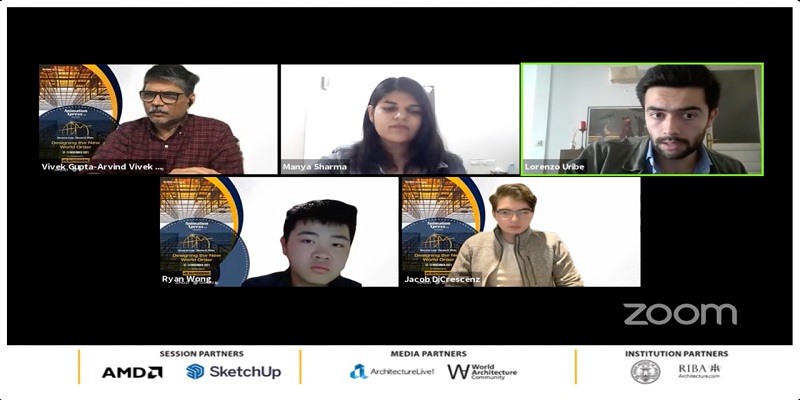
At the AnimationXpress ADM Summit, it was time to know the students’ perspective on how they would like the new world to be. The panel, titled as, ‘Planning the New World with Young Minds’ consisted of students from across the globe. The panelists were University of Melbourne Architecture student Ryan Wong (Hong Kong), Manipal University architecture student Manya Sharma (Jaipur), high school student Jacob DiCrescenz (Evanston), IE University architecture student Lorenzo Uribe (Madrid) and was moderated by Arvind Vivek and Associates principal architect Vivek Gupta (New Delhi).
The students shed light on what will be the future of architecture and how it is evolving over time. Not just that, the panel also poured a new perspective on the architecture and its way forward.
Sharma shared how technological advances have transformed the buildings, monuments, parks, lobby and so on. She presented a beautiful presentation which included the history of architecture evolving with time and technology from Taj Mahal to Eiffel Tower, to modern buildings.
“Architecture has always impacted the world, the large part we see around us. The things are created by the architects from buildings to hotel lobbies, landscape of a park, all of these have been done by architectes and the overall industry has been evolved. Computers have helped to evolve the design game; for example, computer rated designs have enabled architects to actually experiment with new organics and new free forms,” Sharma added.
She has cited an example of the Frank Lloyd Guggenheim museum in Bilbao which is a famous curvy building and to create such a design, technology support is inevitable. Earlier computers were used in the final stage of design and now as we see with algorithms, computers are used in the initial stage of designing.
“Algorithms will actually help in refining, creating and evolving new designs and with different shapes. In fact they could work out the best ways to actually layout the rooms, construct the buildings and change them over time to meet the users’ needs. Architecture and design is actually changing the world and our future,” Sharma explained.
She further shared that going forward, the technology will totally change the game of design with 3D printing, VR and AR, robotics, dynamic facade (can change as per the environment) and so on.
DiCrescenz also shared that going forward, post the pandemic, a lot about society is going to change, including how people will interact with each other and how people lead their daily lives.
“Going forward we need to design in ways where it is sustainable in physical terms considering climate change, to maintain societal sustainability. Designing buildings can consistently generate new forms of societal interaction and generate new relationships between two people in ways that can go beyond,” DiCrescenz added.
The environment in which we are building is going to be vital in designing the new world order. DiCrescenz believes that architecture is purely necessary from an engineering and physical perspective. We can use technology to preserve those buildings for our children and grandchildren. Architectures are full body experience as emotions are filled in it. Emotional cognition is inexplicably intertwined and cannot break the two. Affective neuroscience can help to integrate emotion and design. Emotion is a shared human experience: categorical emotion, intersubjectivity, mentalizing.
According to Wong, going forward it will not be just about economical building but it should be solving real world problems. I think structures should serve purposes rather than having a general function.
“I respect the old architecture and the stories behind it but I feel the way our lives have changed, old architecture cannot respond to it equally so that’s why we need to evolve,” Wong added.
He presented a beautiful presentation on the resilience of architecture which means having a house which produces its own food, energy and water. He shed light on the practical designs where anything and everything is possible. He further mentioned how a school building will have places for people to live in where people can grow crops and sell at the market from the same place. Not just that, even drones and electric cars will be there to transport goods and people inside the complex.
Uribe shared that architecture can change the world and for good. There has been a huge paradigm shift of mass housing, mass building, a homogenous city fabric, and so on that took over to more traditional values to build buildings in the present world.
Uribe believes, “The thing about technology is that, it becomes isolated, it becomes a value in itself. If something is built with them, it may be efficient and might have higher optimising processes that’s appealing to a point but you also need to reflect on what you are applying that technology to.”
He also shared that to a certain extent, as an architect, they give too much importance to the construction companies that can give clients very efficient, easy and cheap solutions. “This kind of opportunity can sideline the architects as a figure. What’s the result of the autonomy of the architect, the point where he/she can connect, can exercise some kind of influence in society, and that is still up for debate. I like to think that the thing that architects can give, construction companies can’t. For example – the sense of artistry, craft and sense of beauty; that’s what you are trained for,”Uribe added.
He further stated how restoration of projects can help to reduce the percentage of carbon emission whereas newer projects will increase it more.
Overall the session was quite insightful and the upcoming architects of the world hinted at a clear picture of how the world and constructions will be going forward.

